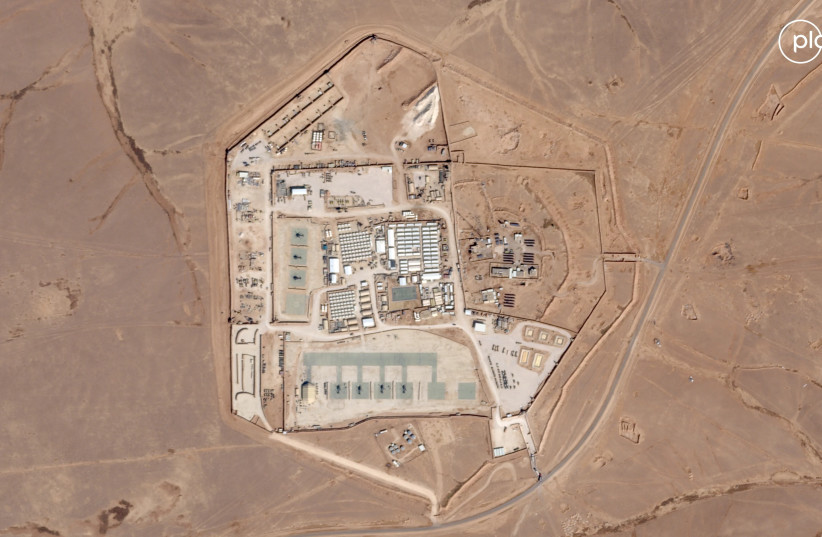The Iranian-backed killing of three American service members in Jordan has shone a spotlight on northeast Jordan and the US’s role in the Jordan-Syria-Iraq border region.
Iran has denied involvement in the attack, but the US has blamed Iranian-backed militias nonetheless. What is clear is that Iranian-backed groups are the only ones that would likely have access to the kind of drones used in the attack.
Additionally, Iran’s Tasnim News Agency bragged about the “Islamic Resistance” in Iraq, a group of pro-Iranian militias, targeting US forces. The Iranian-backed Houthi rebel group in Yemen has called the attack a “message.”
Jordan had sought to create distance between its country and the attack on Sunday night, asserting that it took place in Syria, and that the US garrison at Tanf was the target.
Iranian media said the Iranian proxies had targeted both Tanf and a site called Rukban, which has been referred to as a displaced persons camp in Syria on the Jordanian border. A facility called Tower 22 in Jordan overlooks the site, and it hosts US forces.
Jordan condemned what it called a terrorist attack “that led to the killing of three American soldiers and the wounding of others from the American forces that are cooperating with Jordan in confronting the threat of terrorism and securing the borders,” Amman-based newspaper Al-Ghad reported. Jordan expressed condolences to the Americans who were killed.
Jordan said it would continue to “confront the threat of terrorism and the smuggling of drugs and weapons across the Syrian border into Jordan and will confront with all determination and power anyone who attempts to attack the security of the Kingdom,” the report said. “Jordan had previously announced that it was cooperating with its partners to secure the borders and had asked the United States and other friendly countries to provide it with the necessary military systems and equipment to increase the capabilities to secure the borders.”
The Jordanian statement does not reference Iran or Iranian-backed militias. Instead, it points to “terrorism” and discusses the issue of drug smuggling, which has led to destabilization in the border area between Jordan and Syria in the past. The drug-smuggling operations in Syria are connected to the Syrian regime, and many are also linked to Iranian-backed militias. Jordanian armed forces have clashed with the smugglers over the past year.

The US presence in Jordan and Syria is essential to regional security
The drone attack, the death of US servicemen, and Jordan’s comments shed light on the important role that the US has been playing in Jordan. US forces have been based at Tanf garrison, a small facility in Syria that supported anti-ISIS fighters, just across the border from “Tower 22,” for about six years. When the support for these fighters began, in 2015 or 2016, they were seen as potentially playing a larger role.
At the time, Syrian rebels were holding a part of southern Jordan near Dara’a. The area in Tanf is between Suwaida and the Syrian desert. It is mostly desert, but it is a strategic area because it is near the border area with Iraq. As such, it also has a role to play in what goes on in the Middle Euphrates River Valley, or MERV.
The distances here are large, and the area is not populated, which means even a small force can have a large influence. As such, US forces were working with Syrian rebel groups at Tanf, and those groups influenced a swath of desert. There was a 55-km. zone around Tanf that the US also created. This is a kind of exclusion zone, and the Syrian regime and other forces are not supposed to enter it. This creates a kind of large semicircle on the Jordanian border in Syria.
The Iranian regime has long sought to dominate an area in the Euphrates River Valley that stretches from Albukamal on the border with Iraq to a series of waypoints along the way toward central Syria, sometimes called T2, T3, and T4.
The last of these points, T4, is the Tiyas base near Palmyra where Iran has sometimes based drones and where it tried to move air defenses in 2018. As such, Iran exploits this desert region to move weapons to Syria and to influence Syria and militias in Syria.
Furthermore, Iran tried to establish a base in Albukamal in 2019. The Imam Ali base was supposed to be a storage facility and an influence-peddling site for Iranian-backed militias. Iranian-backed Kataib Hezbollah also had a headquarters in Albukamal in 2018.
The US role in this part of Jordan and Syria creates influence and security that has an essential role to play in the stability of the region. Iran is trying to erode stability, using militias that threaten the US, Israel, Jordan, and other countries to do this.
It doesn’t only transport weapons to groups such as Hezbollah; it also fuels drug smuggling. As such, this area is important to the future of the Middle East.
